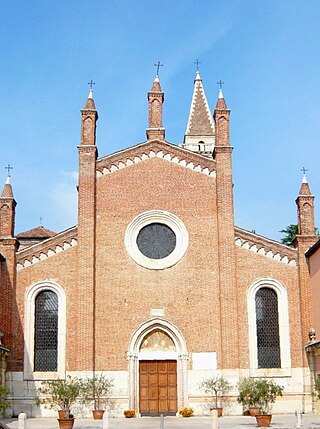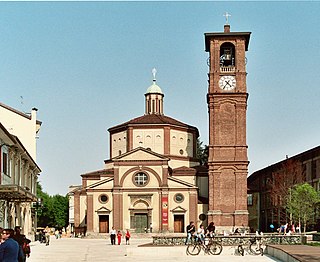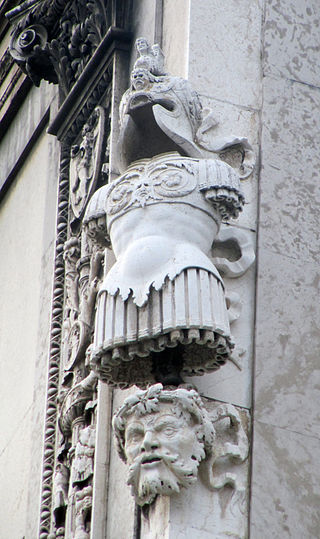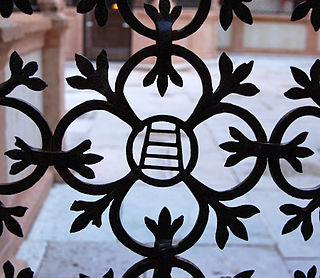
The Basilica dei Santi Giovanni e Paolo, known in Venetian as San Zanipolo, is a Catholic minor basilica and Dominican conventual church in the Castello sestiere of Venice, Italy.

Michele Sanmicheli, sometimes also transcribed as Sammicheli, Sanmichele or Sammichele, was an Italian architect and urban planner who was a citizen of the Republic of Venice.

The history of Verona traces its origins from the foundation of the first settlement on San Pietro hill, probably dating back to the Neolithic period, to the present day: the evidence of such an ancient and rich history can be seen in the landmarks, in the streets and squares, even underground, where the ruins and artifacts of ancient prehistoric and particularly Roman civilizations emerge. It was especially during Roman rule that Verona prospered to become one of the most important cities in northern Italy, a status it maintained even after the fall of the Roman Empire, when the city was repeatedly elevated to capital of Roman-Barbarian kingdoms.

Mantua Cathedral in Mantua, Lombardy, northern Italy, is a Roman Catholic cathedral dedicated to Saint Peter. It is the seat of the Bishop of Mantua.

Bernardino India (1528–1590) was an Italian painter of the late Renaissance, born and mainly active in Verona.

The church of San Pietro da Verona in Santa Anastasia, better known as the basilica of Santa Anastasia, is an important Catholic place of worship that stands in the heart of the historic center of Verona; it is located at the end of the decumanus maximus of the city in Roman times, near the point where the wide meander of the Adige river is crossed by the Ponte Pietra, where the two main traffic routes of the city, road and river, gravitate. It is the largest, most solemn and representative church in Verona, a reflection of a lively moment in the city's life, when the expansion and consolidation of political and economic institutions allowed the community, in synergy with the Scaliger rule, the Dominican clergy and the Castelbarco family, to make a considerable financial effort to build this important temple, a symbol of their power.

San Giorgio in Braida is a Roman Catholic church in Verona, region of Veneto, Italy. A church titled San Giacomo in Braida, was located in Cremona, and became superseded by Sant'Agostino.

San Bernardino is a church in Verona, northern Italy. The church, in Gothic style, was built from 1451 to 1466.

The Abbey of Santa Giustina is a 10th-century Benedictine abbey complex located in front of the Prato della Valle in central Padua, region of Veneto, Italy. Adjacent to the former monastery is the basilica church of Santa Giustina, initially built in the 6th century, but whose present form derives from a 17th-century reconstruction.

The church of Sant'Eufemia is a Catholic place of worship located in the heart of Verona's historic center. It straddles an ancient Roman cardo, where a church building probably already existed in the 6th century. The foundation of the present church is owed to the Della Scala family, who brought Augustinian hermit monks to Verona in 1262 so that they could be closer to the community and granted them permission to build a monastery, located at the time in the Capitani quarter of the Scaliger city. Through bequests and donations, particularly that of Alberto della Scala, the building could be consecrated in 1331 by the bishop of Verona Nicolò. The building activity, however, did not end, and in the following years the monastery's rooms continued to be expanded in order to accommodate the increasing number of monks who arrived there attracted by the great prestige the community boasted. A permit granted by Mastino II della Scala in 1340 made it possible to further enlarge the church by building the vast apse that still distinguishes it today. From the end of the fourteenth century work continued on the various chapels and minor altars.

The Church of Saints Nazarius and Celsus is a Catholic place of worship in Verona located in the Veronetta district, on the road leading to Porta Vescovo. Its origin can be traced to around the 7th century when an early, simple monastic building that was built in the Lombard era was erected at the foot of the overlooking Mount Castiglione. Part of this shrine, originally dedicated to St. Michael the Archangel, still survives with its frescoes and mosaic floors. It was probably a martyrion dedicated to the veneration of the relics of Saints Nazarius and Celsus.

The Basilica of Saint Magnus is the principal church of the Italian town of Legnano, in the province of Milan. It is dedicated to the Saint Magnus, who was Archbishop of Milan from 518 to 530. The church was built from 1504 to 1513 in the Renaissance-style designed by Donato Bramante. The bell tower was added between the years 1752 and 1791. On 18 March 1950, Pope Pius XII named the Basilica of San Magno a minor basilica.

Gasparo Cairano, also known as Gasparo da Cairano, de Cayrano, da Milano, Coirano, and other variations, was an Italian Renaissance sculptor.

The Caprioli Chapel is the second chapel on the left side of the nave of the Church of San Giorgio in Brescia.

The chapel of St. Blaise, located inside the church of Santi Nazaro e Celso in Verona, was built at the behest of the confraternity of San Biagio beginning in 1488 to house the relics of the saint of the same name, bishop of Sebastea in Armenia, which arrived there in 1174 following a German baron. The chapel was designed by architect Beltrame Iarola assisted by Giovanni Maria Falconetto, with the latter also responsible for much of the pictorial decoration. The solemn translation of the relics took place at Easter 1508 but the consecration of the chapel was held later, on January 31, 1529, in a ceremony presided over by Gian Pietro Carafa, the future Pope Paul IV.

Minerva between Geometry and Arithmetic is a fresco fragment, usually attributed to Paolo Veronese, from 1550, but by some art historians to Anselmo Canera or Giambattista Zelotti. It was painted for the Palazzo de Soranzi in Castelfranco Veneto but is now in the Palazzo Balbi, in Venice.

Porta Nuova is a gateway to the historic center of Verona, built between 1532 and 1540. It was designed by architect Michele Sanmicheli. Giorgio Vasari remarked on the gateway in his work Le vite de' più eccellenti pittori, scultori e architettori, stating that it was "never before any other work of more grandeur or better design."

The monuments of Verona are a vast number of architecturally, archaeologically, historically, and artistically significant cultural assets that characterize the city of Verona. Precisely because of the richness of its monuments and the urban evolution that has developed seamlessly over the centuries, UNESCO declared the city a World Heritage Site in 2000.

The churches of Verona are the places of Catholic worship that have been built within the administrative boundaries of the municipality of Verona, evidence of the ups and downs that the city has experienced throughout its history.

Brescian Renaissance sculpture was an important offshoot of Renaissance sculpture developed in Brescia from around the 1460s within the framework of Venetian culture, peaking between the end of the century and the beginning of the next. In this period, a series of public and private worksites were able to produce absolutely original works, ranging from the refined and experimental sculptural style of the church of Santa Maria dei Miracoli to the regular classicism of the Palazzo della Loggia.
































